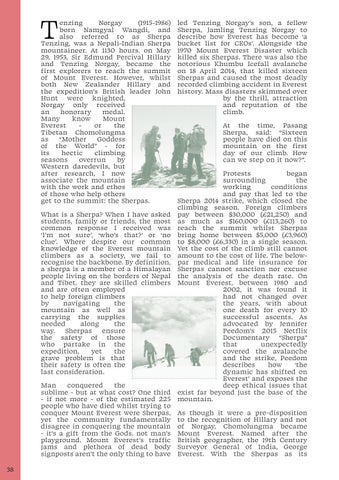T
enzing Norgay (1915-1986) born Namgyal Wangdi, and also referred to as Sherpa Tenzing, was a Nepali-Indian Sherpa mountaineer. At 1130 hours. on May 29, 1953, Sir Edmund Percival Hillary and Tenzing Norgay, became the first explorers to reach the summit of Mount Everest. However, whilst both New Zealander Hillary and the expedition’s British leader John Hunt were knighted, Norgay only received an honorary medal. Many know Mount Everest or the Tibetan Chomolungma as “Mother Goddess of the World” - for its hectic climbing seasons overrun by Western daredevils, but after research, I now associate the mountain with the work and ethos of those who help others get to the summit: the Sherpas. What is a Sherpa? When I have asked students, family or friends, the most common response I received was ‘I’m not sure’, ‘who’s that?’ or ‘no clue’. Where despite our common knowledge of the Everest mountain climbers as a society, we fail to recognise the backbone. By definition, a sherpa is a member of a Himalayan people living on the borders of Nepal and Tibet, they are skilled climbers and are often employed to help foreign climbers by navigating the mountain as well as carrying the supplies needed along the way. Sherpas ensure the safety of those who partake in the expedition, yet the grave problem is that their safety is often the last consideration. Man conquered the sublime - but at what cost? One third - if not more - of the estimated 225 people who have died whilst trying to conquer Mount Everest were Sherpas, yet the community fundamentally disagree in conquering the mountain - it’s a gift from the Gods, not man’s playground. Mount Everest’s traffic jams and plethora of dead body signposts aren’t the only thing to have
38
led Tenzing Norgay’s son, a fellow Sherpa, Jamling Tenzing Norgay to describe how Everest has become ‘a bucket list for CEOs’. Alongside the 1970 Mount Everest Disaster which killed six Sherpas. There was also the notorious Khumbu Icefall avalanche on 18 April 2014, that killed sixteen Sherpas and caused the most deadly recorded climbing accident in Everest history. Mass disasters skimmed over by the thrill, attraction and reputation of the climb. At the time, Pasang Sherpa, said: “Sixteen people have died on this mountain on the first day of our climb. How can we step on it now?”. Protests began surrounding the working conditions and pay that led to the Sherpa 2014 strike, which closed the climbing season. Foreign climbers pay between $30,000 (£21,250) and as much as $160,000 (£113,260) to reach the summit whilst Sherpas bring home between $5,000 (£3,960) to $8,000 (£6,330) in a single season. Yet the cost of the climb still cannot amount to the cost of life. The belowpar medical and life insurance for Sherpas cannot sanction nor excuse the analysis of the death rate. On Mount Everest, between 1980 and 2002, it was found it had not changed over the years, with about one death for every 10 successful ascents. As advocated by Jennifer Peedom’s 2015 Netflix Documentary “Sherpa” that unexpectedly covered the avalanche and the strike, Peedom describes how ‘the dynamic has shifted on Everest’ and exposes the deep ethical issues that exist far beyond just the base of the mountain. As though it were a pre-disposition to the recognition of Hillary and not of Norgay, Chomolungma became Mount Everest. Named after the British geographer, the 19th Century Surveyor General of India, George Everest. With the Sherpas as its









